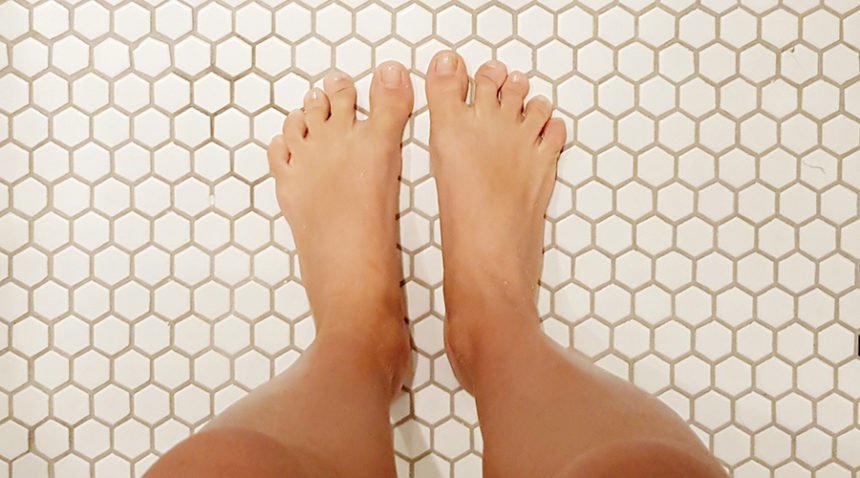Here’s the scene: You are just waking up in the morning. You sit up, swing your legs off the bed, plant your feet on the floor, stand and then it comes—excruciating pain in your heel. As the day progresses, the pain comes and goes.
You may be experiencing plantar fasciitis.
“Plantar fasciitis is something that can affect every action of your day. Imagine having a stone on the bottom of your heel that you just can’t get rid of,” says UNC Health orthopedic surgeon Eric Lukosius, MD, a foot and ankle specialist.
What Is Plantar Fasciitis?
On the bottom of your foot, there is a band of tissue that runs from your heel to your toes called the plantar fascia. The plantar fascia helps to support the arch of your foot and is designed to absorb high stress and strain. When that supporting band gets inflamed, you’re dealing with plantar fasciitis, characterized by a sharp, stabbing pain in the heel.
“It’s inflammation or small micro tears in the origin of the plantar fascia, basically the bottom part of your heel bone. It’s the part that you step on first when you’re getting out of bed,” Dr. Lukosius says.
Dr. Lukosius also describes it as a “start-up” pain. If you’re sitting down for a long time or on a long car ride and then get up, that’s when it’ll hurt. The fascia can relax as you are on your foot, which helps decrease your pain, but with inactivity or after sleeping, the pain can return as the fascia contracts back.
Causes of Plantar Fasciitis and When to See a Doctor
Plantar fasciitis is usually caused by overuse and repetitive stress to the foot.
You’re at increased risk for plantar fasciitis if you:
- Wear improper footwear
- Perform new or increased activity
- Are a runner/athlete
- Have a tight Achilles tendon (tendon that attaches calf muscles to heel bone)
- Have high arches or flat feet
- Are overweight
Plantar fasciitis is extremely common. Dr. Lukosius says he sees about four or five people a day with this condition, both men and women, typically between 40 and 60 years old.
If you’re experiencing foot pain, try rolling a frozen water bottle several times a day under your foot and take NSAIDs such as ibuprofen (Motrin, Advil), or naproxen sodium (Aleve). If your pain persists or if you’re limping and having trouble doing daily activities, it’s time to call your provider. A doctor will be able to diagnose if it is plantar fasciitis by examining your foot and asking questions regarding your pain, and then you can discuss treatment options.
At-Home Tips for Reducing Foot Pain
The first goal of treatment is to protect the plantar fascia from additional strain while it is healing. Here are some ways to do that.
- Wear supportive footwear: Dr. Lukosius recommends a stiff-soled shoe that doesn’t bend easily, which can help reduce stress on the plantar fascia.
- Try a heel cup: A heel cup is a small insert for the back of your shoes, designed to help provide extra support to the heel of the foot.
- Modify your activity: If you like to go for long walks or runs, you’ll want to stop while you’re injured. Let your foot heal first. If you then want to run or walk comfortably for greater distances, gradually increase your activity once you get back into it. Don’t do it all at once.
- Stretch before exercise: Plantar fasciitis is aggravated by many different forces on your feet and calves. Stretch your calf muscles and plantar fascia before any exercise to prevent inflammation and pain.
- Use a night splint: The splint gently stretches the Achilles tendon and the plantar fascia while you sleep.
- See a physical therapist: Physical therapists can offer targeted stretches for your Achilles tendon and plantar fascia and show you how to do them correctly.
It is important to remember that it can take nine to 12 months for plantar fasciitis to resolve, so don’t be disappointed that it is taking a while to get better, Dr. Lukosius says. If your plantar fasciitis is severe, further treatment options can include:
- A local steroid injection that delivers a high dose of anti-inflammatory medicine to the site of your pain.
- Extracorporeal shockwave therapy, a noninvasive procedure that uses shock waves to help reduce pain.
- Surgery, which is extremely rare and usually done when there is another problem in addition to plantar fasciitis that requires surgery.
Your doctor will start with conservative treatments, such as a night splint and physical therapy, and keep trying until your pain is resolved. That way, when you step out of bed in the morning, you can focus on what’s ahead, not the pain in your heel.
If you are experiencing heel pain, talk with your doctor. If you need a doctor, find one near you.

